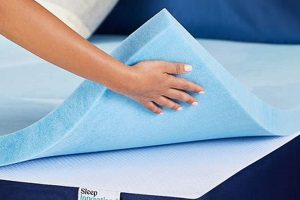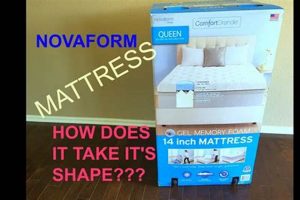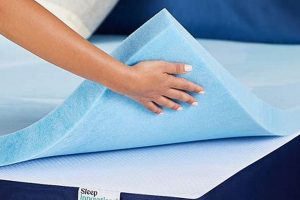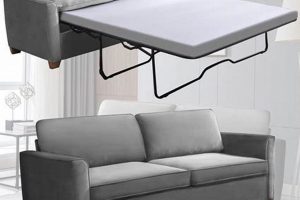A sleeping surface designed for placement directly on the ground, rather than on a bed frame, presents an alternative to traditional bedding configurations. These surfaces typically consist of materials like foam, futon fillings, or specialized constructions intended to provide support and cushioning without the elevation afforded by a bed structure. Examples include rolled mats, foldable platforms, and layered pads intended for ground-level rest.
The adoption of ground-level sleep arrangements can be traced across various cultures and periods. Proponents suggest potential advantages, including cost-effectiveness, space-saving properties, and perceived improvements in spinal alignment. Historically, many societies have utilized floor-based bedding as a standard practice, reflecting diverse cultural norms and practical considerations regarding available resources and living spaces. Contemporary adopters may prioritize minimalist lifestyles, or seek specific ergonomic benefits.
The selection of a suitable ground-level sleeping arrangement necessitates careful consideration of factors such as material composition, thickness, support characteristics, and intended use. Subsequent sections will delve into these aspects, exploring the range of available options and providing guidance on evaluating suitability based on individual needs and preferences. Furthermore, relevant concerns pertaining to hygiene, temperature regulation, and long-term durability will be addressed.
Floor Sleeping Mattress
Optimizing the experience and longevity of a floor sleeping mattress requires adherence to specific guidelines regarding its use and upkeep. These recommendations aim to maximize comfort, maintain hygiene, and prolong the lifespan of the product.
Tip 1: Select Appropriate Thickness: The density and thickness of the floor sleeping mattress are critical for adequate support and pressure relief. A minimum thickness of 4 inches is generally recommended for adults, with thicker options providing enhanced cushioning. Prioritize higher density foam or layered construction to prevent bottoming out and ensure proper spinal alignment.
Tip 2: Ensure Proper Ventilation: Placing the floor sleeping mattress directly on the floor can impede airflow, leading to moisture accumulation and potential mold growth. Implement a breathable barrier, such as a slatted platform or woven mat, beneath the mattress to facilitate ventilation. Regularly lift the mattress to allow for air circulation.
Tip 3: Practice Routine Cleaning: Maintain cleanliness by vacuuming the floor sleeping mattress regularly to remove dust mites and debris. Spot clean spills immediately with a mild detergent and water. Consider using a mattress protector to prevent staining and liquid absorption.
Tip 4: Rotate Frequently: Consistent use in a single position can lead to uneven compression and wear. Rotate the floor sleeping mattress 180 degrees every few weeks to distribute pressure evenly and extend its lifespan. Flip the mattress periodically if it is designed to be reversible.
Tip 5: Consider Environmental Factors: Minimize exposure to direct sunlight, which can degrade the materials over time. Avoid placing the floor sleeping mattress in areas with high humidity or extreme temperature fluctuations. Store the mattress properly when not in use, ensuring it is clean and dry.
Tip 6: Assess Floor Surface: Ensure the floor beneath the floor sleeping mattress is clean, level, and free from sharp objects. A rough or uneven surface can damage the mattress and compromise its structural integrity. A smooth, clean floor will promote even support and prevent premature wear.
Adherence to these guidelines contributes to a more comfortable and hygienic sleep environment while maximizing the durability and longevity of the floor sleeping mattress. Neglecting these practices can lead to premature degradation and potential health concerns.
The following sections will explore specific considerations for different types of floor sleeping mattresses, providing further guidance on optimizing the sleep experience.
1. Supportive Material Composition
The material composition of a floor sleeping mattress dictates its capacity to provide adequate support and maintain structural integrity over extended periods of use. The chosen materials must effectively distribute weight, alleviate pressure points, and resist deformation to ensure a comfortable and ergonomically sound sleep surface.
- Foam Density and Resilience
The density of foam used within the mattress core directly influences its supportiveness and longevity. Higher-density foams, such as memory foam or high-density polyurethane foam, exhibit greater resistance to compression and offer superior support for the spine. Resilience, the ability of the foam to regain its original shape after compression, is also crucial for maintaining consistent support over time. Insufficient density and resilience can lead to sagging and a compromised sleep surface.
- Innerspring Coil Configuration
Innerspring systems, while less common in floor mattresses due to bulk, can contribute to support through strategically arranged coils. The gauge and configuration of the coils, such as individually wrapped pocket coils, determine their ability to conform to body contours and provide targeted support. A well-designed coil system distributes weight evenly and minimizes motion transfer, resulting in a more stable and supportive sleep surface.
- Natural Fiber Composition
Natural fibers like cotton, wool, or latex contribute to breathability, moisture regulation, and overall comfort. Wool, for instance, provides excellent insulation and wicks away moisture, while latex offers inherent resilience and antimicrobial properties. The type and arrangement of these fibers impact the mattress’s ability to regulate temperature and promote a hygienic sleep environment. These components often serve as comfort layers atop more supportive cores.
- Layered Construction and Zoning
The arrangement of different materials in distinct layers allows for customized support and comfort. Zoning, the strategic placement of varying densities of foam or coil configurations, targets specific areas of the body, such as the lumbar region, to provide enhanced support where needed. A well-designed layered construction optimizes pressure relief and promotes proper spinal alignment, leading to a more comfortable and restorative sleep experience.
The interplay between these material characteristics determines the overall supportiveness of a floor sleeping mattress. Selection should consider individual weight, preferred sleep position, and any existing musculoskeletal conditions to ensure adequate support and prevent discomfort or injury. Failing to address these elements could negate the intended benefits of floor-based sleep.
2. Adequate Thickness Levels
The thickness of a floor sleeping mattress is a critical determinant of comfort, support, and overall suitability. Insufficient thickness compromises pressure relief and spinal alignment, negating the potential benefits of ground-level sleep. Conversely, excessive thickness can hinder portability and may not necessarily correlate with improved performance. Establishing adequate thickness levels involves balancing these competing factors.
- Pressure Redistribution and Immersion
Thickness directly influences the mattress’s ability to redistribute body weight and prevent pressure points from forming against the hard floor surface. An insufficient thickness results in inadequate immersion, causing discomfort and potential joint pain. A minimum thickness of 4 inches is generally recommended for adults, but individuals with higher body weights or sensitivities may require greater depth to achieve effective pressure redistribution. The specific material composition also contributes to the overall immersion characteristics at a given thickness level.
- Spinal Alignment and Support
Adequate thickness ensures proper spinal alignment by providing sufficient support to maintain the natural curvature of the spine. A thin mattress may allow the spine to sag, leading to discomfort and potential long-term musculoskeletal issues. The optimal thickness level depends on individual sleep position and body type. Side sleepers, for instance, typically require greater thickness to accommodate shoulder and hip contours, while back sleepers may find a slightly thinner profile adequate for maintaining spinal alignment.
- Thermal Insulation and Floor Contact
The thickness of a floor sleeping mattress provides a degree of thermal insulation, mitigating the effects of a cold or uneven floor. A thicker mattress acts as a more effective barrier against heat loss, contributing to a warmer and more comfortable sleep environment. However, excessive thickness can also impede ventilation, potentially leading to moisture accumulation. Careful consideration should be given to the balance between insulation and breathability when determining appropriate thickness levels.
- Portability and Storage Considerations
While thicker floor sleeping mattresses generally offer enhanced comfort and support, they also present challenges in terms of portability and storage. Thicker mattresses are bulkier and heavier, making them less convenient to move or store when not in use. Individuals who prioritize portability, such as those living in small spaces or those who frequently travel, may need to compromise on thickness to achieve greater ease of handling. Foldable or rollable mattresses offer a viable alternative in such situations, albeit potentially with some reduction in overall support and comfort.
Selecting a floor sleeping mattress with adequate thickness levels necessitates a careful evaluation of individual needs, preferences, and environmental factors. The interplay between thickness, material composition, and intended use determines the overall suitability and effectiveness of the sleeping arrangement. Prioritizing thickness without considering these other variables can lead to suboptimal outcomes and negate the potential benefits of ground-level sleep.
3. Ventilation and Hygiene
Maintaining optimal ventilation and hygiene is paramount when utilizing a floor sleeping mattress. Direct contact with the floor surface inherently increases the risk of moisture accumulation, dust mite infestation, and microbial growth, all of which can compromise sleep quality and pose potential health risks. Mitigating these concerns necessitates a comprehensive approach encompassing material selection, maintenance practices, and environmental control.
- Material Breathability and Moisture Wicking
The inherent breathability of mattress materials plays a crucial role in regulating moisture levels and preventing the proliferation of mold and bacteria. Natural fibers like cotton and wool exhibit superior moisture-wicking properties compared to synthetic alternatives, facilitating airflow and reducing the likelihood of dampness. Conversely, non-breathable materials, such as certain types of closed-cell foam, can trap moisture, creating an environment conducive to microbial growth. Selecting materials with high breathability is essential for maintaining a hygienic sleep surface.
- Air Circulation and Floor Contact Reduction
Direct contact between the floor sleeping mattress and the floor surface impedes air circulation, exacerbating moisture accumulation. Implementing strategies to elevate the mattress slightly, such as utilizing a slatted platform or woven mat, promotes airflow and reduces the risk of dampness. Regular lifting and airing of the mattress also contribute to improved ventilation. Neglecting these practices can lead to the development of mold and mildew, necessitating costly and potentially hazardous remediation measures.
- Dust Mite Control and Allergen Reduction
Floor sleeping mattresses are particularly susceptible to dust mite infestation due to their proximity to the floor, where dust mites tend to concentrate. Employing hypoallergenic mattress covers and regularly vacuuming the mattress can effectively reduce dust mite populations and minimize allergen exposure. Washing bedding frequently in hot water further contributes to dust mite control. Failure to address dust mite concerns can exacerbate allergies and respiratory issues.
- Cleaning Protocols and Stain Prevention
Implementing rigorous cleaning protocols is essential for maintaining the hygiene of a floor sleeping mattress. Promptly addressing spills and stains prevents the growth of bacteria and the development of unpleasant odors. Spot cleaning with appropriate cleaning agents and regular vacuuming are crucial components of a comprehensive cleaning regimen. Employing a mattress protector safeguards the mattress from stains and moisture penetration, extending its lifespan and preserving its hygienic properties.
These facets, working in concert, contribute to a sleep environment that prioritizes both comfort and health. When using a floor sleeping mattress, consistent attention to ventilation and hygiene is not merely a matter of preference but a fundamental requirement for mitigating potential risks and maximizing the benefits of this sleep arrangement. Disregard for these considerations can lead to compromised sleep quality and potential adverse health outcomes.
4. Ergonomic Spinal Alignment
Achieving ergonomic spinal alignment while utilizing a floor sleeping mattress presents a unique challenge, demanding careful consideration of support and posture. The direct contact with a firm surface can either promote or hinder spinal health, contingent on the selection of appropriate materials and the maintenance of proper sleep positioning. When a floor sleeping mattress adequately supports the natural curves of the spine, it can potentially alleviate pressure points and reduce musculoskeletal strain. Conversely, an inadequate or improperly selected floor sleeping mattress may exacerbate existing spinal issues or contribute to the development of new ones. Real-life examples often illustrate that individuals transitioning to floor sleeping arrangements without proper guidance or appropriate mattress selection can experience increased back pain or discomfort. Conversely, those who prioritize spinal alignment through the selection of supportive materials and the adoption of ergonomically sound sleep postures can often report improved sleep quality and reduced back pain.
The practical application of ergonomic principles in floor sleeping mattress selection involves assessing individual spinal needs and sleep preferences. The density and thickness of the mattress should be sufficient to prevent excessive sinking and maintain the natural spinal curvature. Side sleepers, for example, require a mattress with enough give to accommodate the shoulder and hip, while back sleepers need adequate lumbar support to prevent spinal hyperextension. Furthermore, individuals with pre-existing spinal conditions, such as scoliosis or herniated discs, should consult with a healthcare professional to determine the suitability of a floor sleeping arrangement and the optimal mattress characteristics. Additionally, maintaining proper posture during sleep is critical, which may involve the use of pillows to support the head, neck, and knees.
In summary, the relationship between ergonomic spinal alignment and floor sleeping mattress is a complex interplay requiring informed decision-making and proactive posture management. The selection of an appropriate mattress and the adoption of ergonomically sound sleep positions are crucial for promoting spinal health and mitigating potential risks. Challenges may arise in accurately assessing individual spinal needs and selecting a mattress that adequately addresses those needs. However, by prioritizing ergonomic principles and seeking professional guidance when necessary, individuals can maximize the potential benefits of a floor sleeping arrangement and minimize the likelihood of adverse spinal consequences.
5. Portability and Storage
The inherent nature of a floor sleeping mattress often necessitates consideration of its portability and storage characteristics. Unlike conventional bed setups that remain stationary, floor sleeping arrangements frequently require relocation for cleaning, space optimization, or travel purposes. The ease with which a mattress can be moved and stored directly impacts its practicality and suitability for diverse living situations.
- Weight and Dimensions
The weight and dimensions of a floor sleeping mattress are primary determinants of its portability. Lighter and more compact models are inherently easier to transport and store, particularly in confined spaces. Full-size or larger mattresses constructed from dense materials can present significant logistical challenges. For instance, a thick memory foam floor mattress may offer superior comfort but prove unwieldy for frequent relocation, while a thinner, lighter option might sacrifice some support in favor of enhanced portability.
- Folding and Rolling Mechanisms
Certain floor sleeping mattresses incorporate folding or rolling mechanisms to facilitate compact storage. Tri-fold mattresses, for example, can be folded into a relatively small footprint when not in use, maximizing available floor space. Similarly, rollable mattresses allow for easy storage in closets or against walls. However, the effectiveness of these mechanisms depends on the material composition and construction quality; some folding mattresses may exhibit reduced durability or comfort along the fold lines.
- Carrying and Securing Features
The presence of carrying handles or securing straps significantly enhances the portability of a floor sleeping mattress. Handles provide a convenient grip for lifting and maneuvering, while straps enable secure compression for transport or storage. These features are particularly valuable for larger or heavier mattresses, mitigating the risk of damage or injury during relocation. The absence of such features can render even relatively lightweight mattresses cumbersome to handle.
- Storage Space Requirements
The availability of adequate storage space directly influences the practicality of a floor sleeping mattress. Individuals residing in apartments or homes with limited storage capacity may need to prioritize compact, easily storable models. Foldable or rollable mattresses offer a distinct advantage in such scenarios, minimizing the required storage volume. Conversely, those with ample storage space may have greater latitude in selecting larger, more luxurious floor sleeping mattresses without compromising convenience.
The interplay of these considerations ultimately determines the practicality of a floor sleeping mattress in a given living environment. Prioritizing portability and storage features can enhance the versatility and convenience of a floor sleeping arrangement, particularly in situations where space optimization and ease of relocation are paramount. Conversely, neglecting these factors can lead to logistical challenges and diminished usability.
6. Durability and Lifespan
The durability and lifespan of a floor sleeping mattress represent critical considerations for prospective users. Given the direct contact with the floor and potential for increased exposure to environmental factors, the structural integrity and longevity of these mattresses are essential for ensuring long-term comfort, support, and cost-effectiveness.
- Material Degradation and Compression
The materials used in a floor sleeping mattress are susceptible to degradation and compression over time, impacting their ability to provide adequate support. Foam density, fiber resilience, and coil construction (if applicable) directly influence the rate of degradation. Lower-quality materials may exhibit accelerated compression and loss of support, shortening the mattress’s lifespan. For example, a low-density foam mattress may compress significantly within a year, requiring replacement, while a high-density latex mattress could maintain its support for several years under similar conditions.
- Moisture Exposure and Microbial Growth
Floor sleeping mattresses are at greater risk of moisture exposure from spills, humidity, and inadequate ventilation. Prolonged moisture exposure can lead to microbial growth, including mold and mildew, which compromise the mattress’s structural integrity and pose health risks. The type of material also influences susceptibility; natural fibers like cotton are more prone to moisture retention compared to synthetic materials. Proper ventilation and the use of moisture-resistant covers can mitigate these risks and extend the mattress’s lifespan.
- Structural Integrity and Seam Strength
The structural integrity of a floor sleeping mattress, including seam strength and overall construction quality, determines its ability to withstand the rigors of regular use. Weak seams or poorly constructed edges can lead to premature wear and tear, reducing the mattress’s lifespan. Reinforcing seams and using durable stitching techniques enhance structural integrity, particularly in mattresses designed for frequent folding or rolling. Real-world examples of inexpensive floor mattresses often showcase compromised seam strength and rapid disintegration along edges.
- Maintenance Practices and Cleaning Protocols
Adherence to proper maintenance practices and cleaning protocols significantly impacts the durability and lifespan of a floor sleeping mattress. Regular vacuuming, spot cleaning, and the use of mattress protectors prevent the accumulation of dust mites, allergens, and stains, which can degrade the materials over time. Neglecting these practices accelerates material breakdown and reduces the mattress’s overall lifespan. A mattress that is regularly cleaned and protected can maintain its integrity and comfort for a significantly longer period compared to one that is neglected.
In conclusion, the durability and lifespan of a floor sleeping mattress are multifaceted attributes influenced by material quality, environmental factors, structural integrity, and maintenance practices. Selecting a mattress constructed from durable materials and implementing proper care protocols are essential for maximizing its lifespan and ensuring long-term value. The interaction of these elements ultimately defines the longevity and sustained performance of the floor sleeping mattress.
Frequently Asked Questions
This section addresses common inquiries and concerns regarding floor sleeping mattresses, providing clear and concise information to aid in informed decision-making.
Question 1: What are the primary advantages of utilizing a floor sleeping mattress compared to a traditional bed frame?
Floor sleeping mattresses offer potential advantages, including cost savings, space efficiency, and perceived improvements in spinal alignment. The absence of a bed frame eliminates the associated expense, while the low profile maximizes available floor space. Anecdotal evidence suggests that direct contact with a firm surface can promote improved spinal posture for some individuals.
Question 2: Are there specific health considerations associated with sleeping on a floor sleeping mattress?
Potential health considerations include increased exposure to dust mites, potential for moisture accumulation, and challenges in maintaining proper spinal alignment. Individuals with allergies or respiratory sensitivities may experience exacerbated symptoms due to increased dust mite exposure. Inadequate ventilation can promote mold and mildew growth, while improper mattress selection can compromise spinal health. Careful attention to hygiene, ventilation, and mattress selection is crucial to mitigating these risks.
Question 3: What is the recommended thickness for a floor sleeping mattress to ensure adequate support?
A minimum thickness of four inches is generally recommended for adult users. Thicker mattresses provide greater cushioning and support, but may also compromise portability. The optimal thickness depends on individual weight, sleep position, and sensitivity to pressure points. Individuals with higher body weights or existing musculoskeletal conditions may require thicker mattresses to ensure adequate support and prevent discomfort.
Question 4: How can ventilation be optimized when using a floor sleeping mattress?
Optimizing ventilation involves elevating the mattress slightly above the floor surface and selecting breathable materials. Utilizing a slatted platform or woven mat beneath the mattress promotes airflow and reduces moisture accumulation. Regularly lifting and airing the mattress also enhances ventilation. Avoiding placement in humid or poorly ventilated areas further minimizes moisture-related risks.
Question 5: What cleaning and maintenance practices are essential for preserving the hygiene of a floor sleeping mattress?
Essential cleaning and maintenance practices include regular vacuuming, spot cleaning, and the use of mattress protectors. Vacuuming removes dust mites and allergens, while spot cleaning addresses spills and stains. Mattress protectors provide a barrier against moisture and dirt. Frequent washing of bedding in hot water further contributes to dust mite control and overall hygiene.
Question 6: How does the lifespan of a floor sleeping mattress compare to that of a traditional mattress?
The lifespan of a floor sleeping mattress depends on material quality, usage patterns, and maintenance practices. Generally, well-maintained, high-quality floor sleeping mattresses can exhibit comparable lifespans to traditional mattresses. However, increased exposure to environmental factors and potential for compression may reduce the lifespan of lower-quality models. Regular rotation and proper care contribute to maximizing the lifespan of a floor sleeping mattress.
In summary, informed decision-making regarding floor sleeping mattresses necessitates careful consideration of potential benefits, health considerations, material selection, and maintenance practices. Addressing these factors ensures a comfortable, hygienic, and supportive sleep environment.
The following section will provide detailed guidelines on selecting the most suitable floor sleeping mattress based on individual needs and preferences.
Conclusion
The preceding analysis has examined the floor sleeping mattress from multiple perspectives, encompassing its characteristics, usage, maintenance, and potential advantages and disadvantages. Key considerations include material composition, thickness levels, ventilation, spinal alignment, portability, and durability. The information presented aims to provide a comprehensive understanding of the factors influencing the suitability and performance of this alternative sleep arrangement.
Ultimately, the decision to adopt a floor sleeping mattress necessitates careful assessment of individual needs, preferences, and environmental constraints. Prioritizing informed decision-making, coupled with diligent maintenance practices, is paramount for maximizing the potential benefits and mitigating the inherent risks associated with this sleep modality. Further research and consultation with healthcare professionals are encouraged for individuals with specific health concerns or musculoskeletal conditions, to ensure informed choices regarding sleep support and spinal health.







